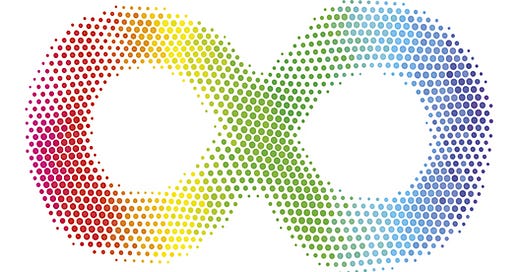
What is neurodiversity?
Neurodiversity is a relatively new-ish term and it has its origins in the Autistic Rights Movement that sprung up in the 1990s within the autistic community. In particular, the term neurodiversity was first used in the late 90s by Judy Singer, an autistic Australian sociologist, and Harvey Blume, a New York journalist, to articulate the needs of people with autism who did not want to be defined by their disability but wished to be seen instead as neurologically different. According to this perspective, neurologically different individuals represent a new addition to the already familiar political categories of class/gender/race.
But what is neurodiversity? There’s no clear definition for neurodiversity (yet)! The term is often used to refer to the vast range of neurocognitive variability within the human population; human brains have different ways of working and interpreting information. The neurodiversity movement highlights that people naturally think about things differently. We have different interests and motivations and are naturally better at some things and poorer at others. Traditional medical models of mental health focus on disability but this approach sees neurodiversity as something positive similar to biodiversity.
“Diversity among brains is just as wonderfully enriching as biodiversity and the diversity among cultures and races.”
Thomas Armstrong in “Neurodiversity”
Even though it was initially associated with autism spectrum condition (ASC), it now encompasses all mental health disorders of neurological origin including Attention Deficit Hyperactivity Disorder (ADHD), dyslexia, mood disorders, anxiety disorders, schizophrenia, and others. It is estimated that around 15-20% of the population is neurodiverse (Doyle, 2020). That’s a significant minority. For example, in the UK that would mean that about 10,281,503 people are neurodiverse, almost as many people as the population of Greece!
According to Blume, “Neurodiversity may be every bit as crucial for the human race as biodiversity is for life in general. Who can say what form of wiring will prove best at any given moment?” How absurd it would be to label a calla lily as having “petal deficit disorder” or to diagnose a person from Holland as suffering from “altitude deprivation syndrome.”

As UX professionals we should keep neurodiversity in mind when we work in two main ways:
When designing experiences and testing them with users.
When collaborating with co-workers and managing teams.
Designing for neurodiversity
It would probably take multiple posts or a book to cover this issue so this will be just a quick overview.
1. Mind that font
Don’t choose a font based on aesthetics alone. Choosing the right typeface can be a complex topic when designing with neurodiversity in mind. Research suggests that sans serif fonts are more suitable for people with dyslexia (e.g., Arial, Calibri). Serif font styles on the other hand have been found less readable for a neurodiverse audience. Font size also matters — larger fonts can be easier to read for neurodiverse readers.

2. People make mistakes
This can be a bigger challenge for neurodiverse users. Some conditions can affect cognitive functions, such as memory, attention, or executive functions. There are two ways we can help: a) come up with ways to prevent user errors, and b) be forgiving when an error occurs. One of my favourite examples of error prevention is the famous “it seems like you have forgotten to attach a file” notification you get in Gmail if you try forgetting to attach a file to your email.
An example of giving users the chance to recover from an error also comes from Gmail, which gives you a few seconds after sending an email to undo your action.
3. Copy matters
Avoid using complex language and jargon unless you really have to (e.g., you’re creating a product for a very specific audience). Everyone benefits from simple, clearer copy, not just your neurodiverse users. Some ways to do this are by using active voice when possible, avoiding double negative or long sentences, and avoiding metaphors. You should also pay attention to your microcopy. Some neurodiverse users dislike ambiguity, so try reducing it by having descriptive microcopy. For example, avoid vague statements such as “click here”. You can also use copy to reassure users what the process is. A good example of this is the copy you see when you click reserve on Airbnb informing you that “you won’t be charged yet”.
4. Consider sensory issues
Sensory issues are very common among neurodiverse people (fun fact: before leaving academia I used to do research on sensory processing). Different people have different needs so finding the right balance can be tricky. Avoid auto-playing videos or audio. Give users control over this. As someone on the spectrum who loves baking, there’s nothing more frustrating than having to deal with recipe websites on a mobile phone.
If you provide video or audio, try including subtitles or a transcript. Certain conditions affect auditory processing so giving users an alternative can be helpful. It can also benefit neurotypicals when they can’t use audio. It’s a win-win situation.
5. Be consistent
This is something that you should be striving for anyway but it becomes even more important when dealing with neurodiverse users.
6. Know your user
Tips from UX blogs cannot replace actual user research. Test your designs with your users. Considering how common neurodiversity is, there’s a big chance you’re already talking to neurodiverse users without knowing it.
Neurodiversity in the workplace
Many designers and UX professionals I meet admit to being neurodiverse themselves. So chances are you are already working with neurodiverse people — you might even be one yourself! Be more understanding and kinder to ensure everyone in the team thrives. I’ll write a longer post on this at some point but here are some ways you can help:
start at the hiring process: the hiring process is by default designed for neurotypicals. Give applicants a chance to disclose any needs they have and make sure to give them enough time to work on any assignments. The whiteboard challenge is not the most inclusive challenge. Consider using alternatives.
create a flexible, honest work environment: it’s important to respect people’s needs when it comes to ways of working. For some neurodiverse individuals working remotely is essential, for others having an office is crucial. Listen to their needs and adapt. Flexibility and empathy. If your employees need to come to the office, ensure that it’s suitable and it provides quiet spaces.
educate the team: give your employees opportunities to learn more about neurodiversity. Start a weekly group or invite experts to talk about it. Ensure your managers are knowledgeable.
PS: this article is a very quick intro/overview. The neurodiversity movement isn’t without its critics.







